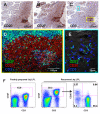Reduced expression of CD27 by collagenase treatment: implications for interpreting b cell data in tissues
- PMID: 25756877
- PMCID: PMC4355594
- DOI: 10.1371/journal.pone.0116667
Reduced expression of CD27 by collagenase treatment: implications for interpreting b cell data in tissues
Abstract
Surface markers have been used to identify distinct cell subpopulations and to delineate various stages of maturation or activation of lymphocytes. In particular CD27 is used for delineation of naïve and memory B cell populations, and is readily detected by flow cytometry. We here used flow cytometry to examine the expression of CD27 on lymphocytes isolated from various tissues of rhesus macaques, and found its expression was consistently low to absent on intestinal cell suspensions. However, immunohistochemistry revealed abundant CD27+ cells in intestinal tissue sections. Further investigation showed the marked loss of CD27 expression on processed intestinal cells was due to collagenase digestion of intestinal tissues, yet CD27 expression was recoverable within hours of cell isolation. By combining confocal microscopy, we confirmed that only a fraction of B cells express CD27, in contrast to expression on all T cells from tissues examined including the gut. Taken together, our results suggest that CD27 may be a memory marker for B cells, but not for T cells, since essentially all CD3 T cells expressed CD27. In summary, it is important to consider the influence of isolation procedures on cell surface expression of phenotypic markers, especially when examining tissue-resident lymphocytes by flow cytometry.
Conflict of interest statement
Figures




Similar articles
-
Naïve and memory B cells in the rhesus macaque can be differentiated by surface expression of CD27 and have differential responses to CD40 ligation.J Immunol Methods. 2011 Jan 5;363(2):166-76. doi: 10.1016/j.jim.2010.09.017. Epub 2010 Sep 24. J Immunol Methods. 2011. PMID: 20875419 Free PMC article.
-
Loss of memory (CD27) B lymphocytes in HIV-1 infection.AIDS. 2001 May 25;15(8):957-64. doi: 10.1097/00002030-200105250-00003. AIDS. 2001. PMID: 11399977
-
Reduced memory B-cell populations in boys with B-cell dysfunction after bone marrow transplantation for X-linked severe combined immunodeficiency.Br J Haematol. 2001 Mar;112(4):1004-11. doi: 10.1046/j.1365-2141.2001.02639.x. Br J Haematol. 2001. PMID: 11298599
-
Memory B cells and CD27.Histol Histopathol. 2000 Apr;15(2):573-6. doi: 10.14670/HH-15.573. Histol Histopathol. 2000. PMID: 10809378 Review.
-
The role of CD27 in anti-viral T-cell immunity.Curr Opin Virol. 2017 Feb;22:77-88. doi: 10.1016/j.coviro.2016.12.001. Epub 2017 Jan 12. Curr Opin Virol. 2017. PMID: 28086150 Review.
Cited by
-
Optimization of processing female genital tissue samples for lymphocyte analysis by flow cytometry.Am J Reprod Immunol. 2020 May;83(5):e13227. doi: 10.1111/aji.13227. Epub 2020 Feb 13. Am J Reprod Immunol. 2020. PMID: 31991032 Free PMC article.
-
Inside the Joint of Inflammatory Arthritis Patients: Handling and Processing of Synovial Tissue Biopsies for High Throughput Analysis.Front Med (Lausanne). 2022 Mar 14;9:830998. doi: 10.3389/fmed.2022.830998. eCollection 2022. Front Med (Lausanne). 2022. PMID: 35372383 Free PMC article. Review.
-
Increased HIV-1 transcriptional activity and infectious burden in peripheral blood and gut-associated CD4+ T cells expressing CD30.PLoS Pathog. 2018 Feb 22;14(2):e1006856. doi: 10.1371/journal.ppat.1006856. eCollection 2018 Feb. PLoS Pathog. 2018. PMID: 29470552 Free PMC article.
-
Soluble and Microparticle-Based Delivery of TLR4 and TLR9 Agonists Differentially Modulate 3D Chemotaxis of Bone Marrow-Derived Dendritic Cells.Adv Healthc Mater. 2021 Aug;10(15):e2001899. doi: 10.1002/adhm.202001899. Epub 2021 Apr 30. Adv Healthc Mater. 2021. PMID: 33928762 Free PMC article.
-
An Optimized and Validated Method for Isolation and Characterization of Lymphocytes from HIV+ Human Gut Biopsies.AIDS Res Hum Retroviruses. 2017 Nov;33(S1):S31-S39. doi: 10.1089/AID.2017.0208. AIDS Res Hum Retroviruses. 2017. PMID: 28882052 Free PMC article.
References
-
- Hendriks J, Gravestein LA, Tesselaar K, van Lier RA, Schumacher TN, et al. (2000) CD27 is required for generation and long-term maintenance of T cell immunity. Nat Immunol 1: 433–440. - PubMed
-
- Hintzen RQ, Lens SM, Lammers K, Kuiper H, Beckmann MP, et al. (1995) Engagement of CD27 with its ligand CD70 provides a second signal for T cell activation. J Immunol 154: 2612–2623. - PubMed
-
- Nagumo H, Agematsu K, Shinozaki K, Hokibara S, Ito S, et al. (1998) CD27/CD70 interaction augments IgE secretion by promoting the differentiation of memory B cells into plasma cells. J Immunol 161: 6496–6502. - PubMed
Publication types
MeSH terms
Substances
Grants and funding
LinkOut - more resources
Full Text Sources
Other Literature Sources
Research Materials

